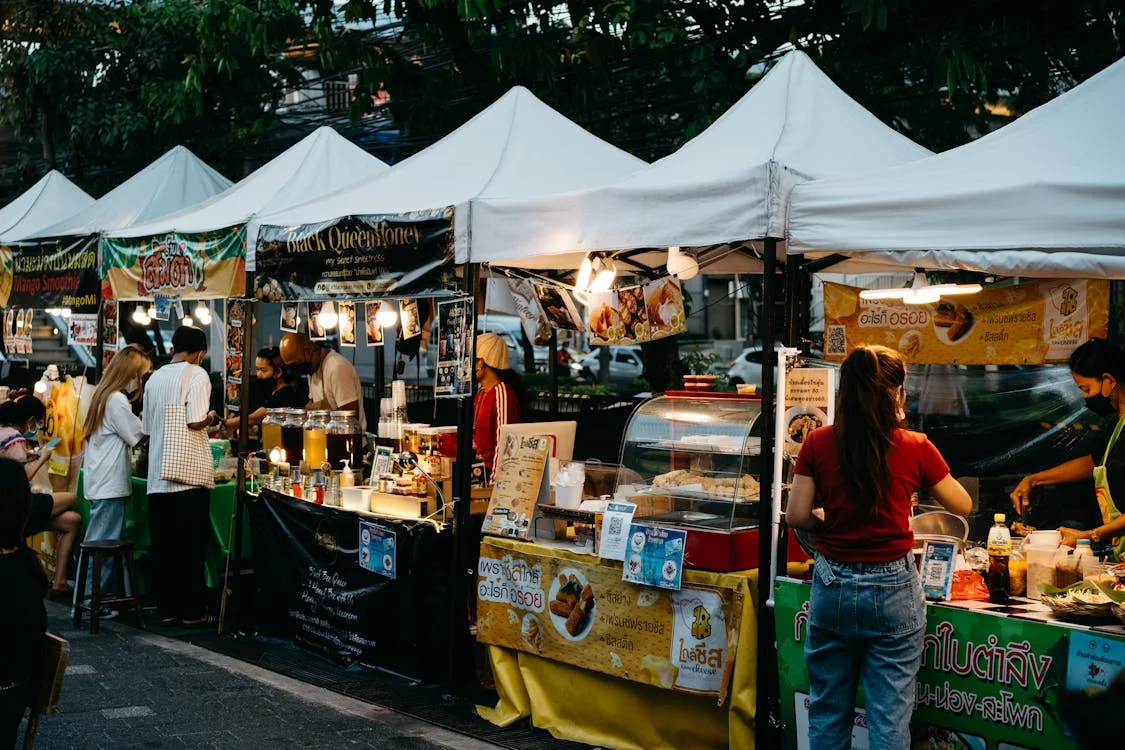Thailand is famous for its amazing food — bold flavors, colorful dishes, and recipes passed down through generations. Whether you’re grabbing a quick bite at a street stall in Bangkok or enjoying a home-cooked meal in Chiang Mai, you’ll quickly realize how important food is to Thai culture.
In this guide, you’ll discover the local foods to try in Thailand that go way beyond Pad Thai and green curry. Get ready for a flavorful journey filled with sweet, spicy, sour, and salty dishes that you’ll remember long after your trip.
Thailand was a revelation to me; the landscapes, the culture, the food and the people
Fiona Bruce

As you travel through different regions of Thailand, the food changes too. In the northeast (Isan), the dishes are spicy and full of herbs. In the south, food is creamier and uses a lot of coconut. Each region has its own special ingredients and cooking style — and that’s what makes eating in Thailand so exciting!
Before you head out to explore Thailand’s amazing food scene, make sure you stay connected. With Gohub’s international eSIM, you’ll get fast, reliable internet across the country. It’s perfect for finding local food spots, translating menus, or posting your favorite food photos (because mango sticky rice deserves to be shared). No roaming fees, no slow Wi-Fi — just smooth travel and tasty adventures.
I. The Essential Flavor Profiles of Thai Cuisine
Before you dive into all the local foods to try in Thailand, it helps to understand the flavor magic that makes Thai cuisine so unforgettable. Thai food isn’t just delicious — it’s balanced, bold, and deeply rooted in tradition. Every dish is crafted with a careful mix of taste, aroma, and texture that excites all your senses.
Understanding the Balance of Thai Flavors
One of the things that makes Thai food so special is how it brings sweet, sour, spicy, and salty together in perfect harmony. Unlike many Western dishes that focus on just one or two flavors, Thai cuisine blends all four — sometimes in a single bite!
Here’s a quick guide to how those flavors show up in Thai cooking:
- Sweet: Comes from palm sugar, coconut milk, or ripe fruits
- Sour: Often from lime juice, tamarind, or green mango
- Spicy: Delivered through fresh and dried chilies
- Salty: Usually added using fish sauce (nam pla), not regular table salt
And it’s not just about taste — Thai food smells amazing too! Herbs like lemongrass, Thai basil, galangal, and kaffir lime leaves give Thai dishes their fresh, fragrant character.

Image: Fresh Thai ingredients
The Role of Rice in Thai Food Culture
Rice isn’t just a side dish in Thailand — it’s the heart of the meal. In fact, one of the most common greetings in Thai is “Kin khao yang?” which means “Have you eaten rice yet?” That says everything about how central rice is to daily life and food culture.
When exploring the local foods to try in Thailand, you’ll notice that rice comes in different forms depending on where you are. Here are the two main types:
Jasmine Rice (Khao Hom Mali)
This is the soft, fragrant white rice you’ll find across most of Central and Southern Thailand. It’s the perfect pairing for curries, stir-fries, and grilled dishes. Light, fluffy, and slightly floral — it quietly supports all the bold flavors on the plate.
Sticky Rice (Khao Niew)
In Northern and Northeastern Thailand (Isan), sticky rice is king. It’s glutinous, chewy, and usually rolled into small balls — perfect for scooping up spicy salads, grilled meats, or dips like nam prik. It’s more hands-on, more fun, and totally delicious.
II. Must-Try Street Food Experiences in Thailand
Street food is where Thai cuisine truly comes alive — vibrant, flavorful, and full of character. Whether you’re wandering through a night market in Chiang Mai or grabbing a late-night snack in Bangkok, you’ll find some of the best local foods to try in Thailand right on the sidewalk.
Bangkok Street Food: The Ultimate Urban Food Adventure
Bangkok’s streets are a paradise for food lovers. Areas like Chinatown (Yaowarat), Sukhumvit Soi 38, and the Old City (Rattanakosin) light up at night with sizzling woks, smoky grills, and the irresistible scent of street eats.
Pad Thai – Thailand’s Famous Noodle Dish
This world-renowned stir-fried noodle dish is made with rice noodles, tofu, eggs, bean sprouts, and your choice of shrimp or chicken.
What makes it fun? You get to customize it yourself with condiments like:
- Crushed peanuts
- Chili flakes
- Lime wedges
- A pinch of sugar
✨ Pro tip: Pad Thai from a street cart hits different — fresh off the wok and cooked just for you!
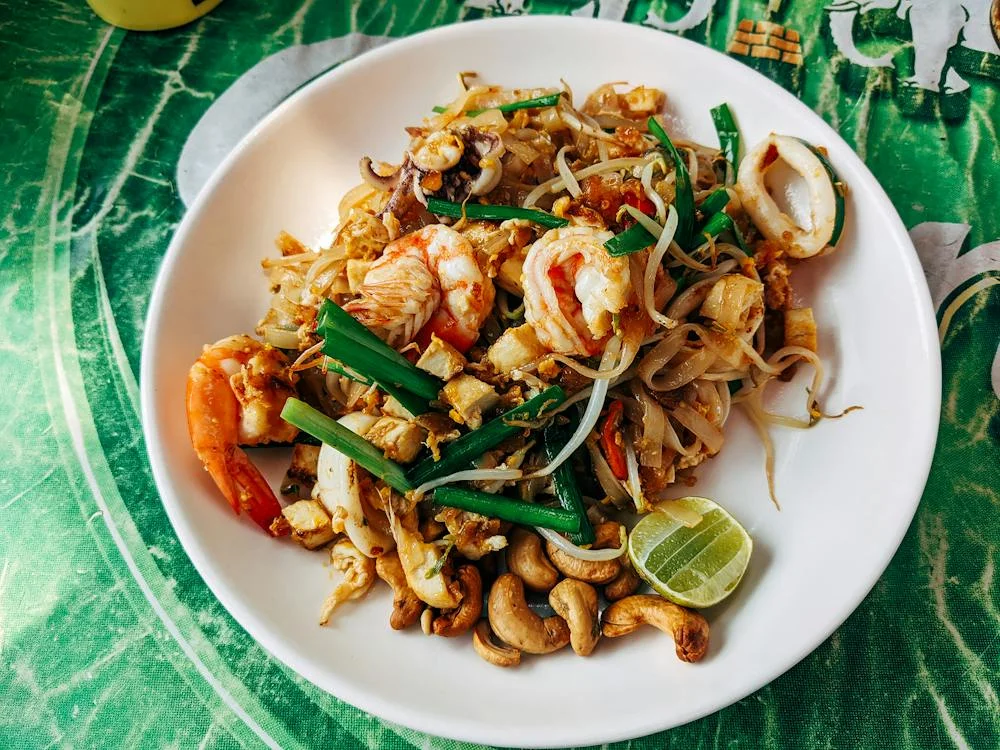
Image: Authentic Pad Thai
Som Tam – Spicy Green Papaya Salad
A staple from Northeastern Thailand (Isan), Som Tam is spicy, tangy, and refreshing all at once.
It’s made by pounding:
- Shredded green papaya
- Tomatoes
- Long beans
- Garlic, chilies, lime juice, palm sugar & fish sauce
All in a mortar and pestle for that signature flavor punch.
Traveler tip: If you’re not big on spice, say “pet noi” (just a little spicy) when ordering.
💡 With Gohub’s eSIM, you can look up phrases, find hidden food gems, or even translate menus — all on the go, no roaming fees!
Northern Thai Street Food: Rustic & Rich in Flavor
In places like Chiang Mai and Chiang Rai, the street food scene feels completely different — more rustic, deeply spiced, and influenced by nearby Myanmar and Laos. Here are two dishes you can’t miss:
Khao Soi: Northern Thailand’s Signature Curry Noodle Soup
A rich and comforting bowl of egg noodles in a creamy coconut curry broth, topped with:
- Crispy fried noodles
- Pickled mustard greens
- Shallots
- Lime & chili oil
- Usually made with chicken (Khao Soi Gai), this dish is a warm hug in a bowl.

Image: Khao Soi
Sai Oua (Northern Thai Herb Sausage)
This flavorful grilled sausage is packed with:
- Lemongrass
- Kaffir lime leaves
- Galangal & chilies
- You’ll find it sizzling at local markets — often served with sticky rice and fresh herbs.
Thai street food is not just cheap and tasty — it’s a cultural experience. And some of the most authentic local foods to try in Thailand are found right here, on the curbside.
🏝️ Already dreaming of your next foodie trip? Here are the best places to visit in Thailand — from bustling Bangkok to calm island towns, paired perfectly with pad Thai.
III. Regional Thai Cuisine: A Culinary Map of Thailand
One of the most exciting things about exploring the local foods to try in Thailand is how much the flavors change as you travel from region to region. From the fiery dishes of the northeast to the coconut-heavy curries of the south, each area brings its own unique twist to Thai cuisine.
Let’s take a delicious detour through two flavor-packed regions: Isaan (northeast) and Southern Thailand.
Northeastern Thai Food (Isaan): Bold, Spicy, and Herb-Forward
Located along the borders of Laos and Cambodia, Isaan cuisine is punchy, rustic, and full of personality. Expect grilled meats, sticky rice, and flavors that hit hard and fast — especially chili!
Larb – Spicy Minced Meat Salad
Larb (also spelled Laab) is a zesty mix of minced pork, chicken, or duck tossed with:
- Lime juice
- Roasted rice powder
- Fish sauce
- Fresh herbs & red chili flakes
It’s spicy, citrusy, and best enjoyed with sticky rice and crisp raw veggies on the side.
Gai Yang – Isaan Grilled Chicken
This beloved street food staple features chicken marinated in garlic, coriander root, fish sauce, and black pepper — then grilled slowly over charcoal.
✨ It’s juicy, smoky, and perfectly paired with Som Tam (green papaya salad) and sticky rice for the ultimate Isaan combo plate.
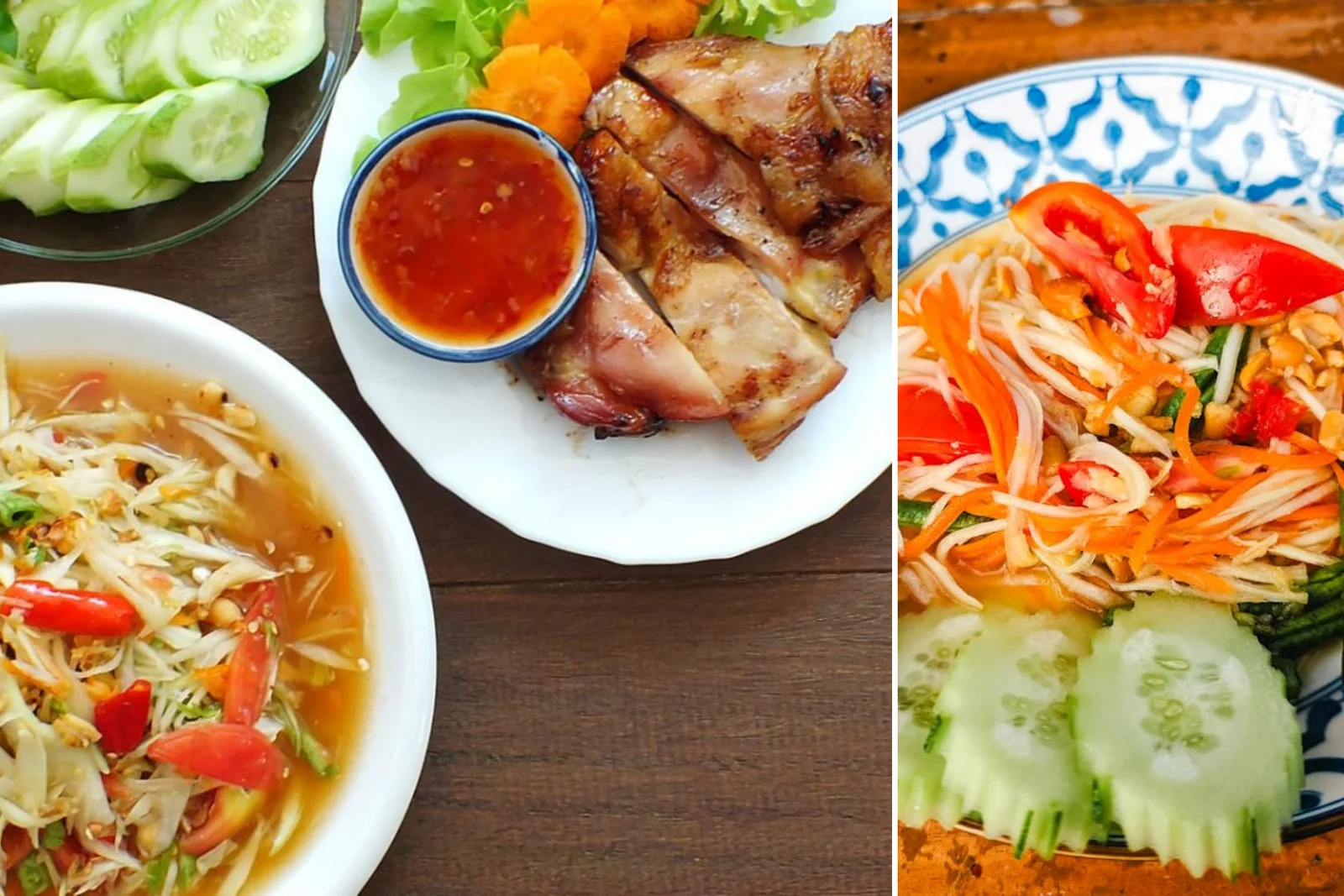
Image: Isaan-style Gai Yang grilled chicken with Som Tam
Southern Thai Cuisine: Intense, Spicy & Seafood-Centric
Southern Thai food is influenced by its coastal location and Malaysian roots. Here, dishes tend to be spicier and richer — with bold curries, seafood galore, and a generous use of turmeric.
Gaeng Tai Pla – Fermented Fish Entrail Curry
This is serious foodie territory. Gaeng Tai Pla is made with fermented fish guts (yes, really!), eggplant, bamboo shoots, and a potent southern-style curry paste.
It’s one of the spiciest local foods to try in Thailand, and not for the faint of heart — but definitely a must-try for adventurous eaters!
Khao Mok Gai – Southern Thai Biryani
Influenced by Thai Muslim communities, this dish is a Thai take on biryani:
- Yellow turmeric rice
- Tender braised chicken
- Served with sweet chili sauce and fresh cucumber relish
- Fragrant and comforting, it’s a standout southern dish you’ll find in places like Hat Yai and Songkhla.
Travel Tip: Heading to Phuket, Krabi, or the southern provinces to hunt down these regional gems? With Gohub’s international eSIM, you’ll stay connected even in smaller towns — perfect for navigating to local eateries off the tourist trail or using Google Translate when ordering Gaeng Tai Pla
If you love spices in Thai food, wait till you try Moroccan cuisine.
IV. Thai Curries: A Rainbow of Flavors
Thai curry is one of the most beloved and flavorful parts of Thai cuisine — and it comes in many different forms, each with its own color, spice level, and cultural story. If you’re exploring local foods to try in Thailand, diving into its curry varieties is a must.
From the fiery green curry of central Thailand to the warming Massaman of the south, Thai curries aren’t just comfort food — they’re a perfect example of how Thai cooking blends herbs, spices, and history into every bite.
The Essential Thai Curry Guide for Travelers
One of the most exciting local foods to try in Thailand is Thai curry — rich, aromatic, and incredibly diverse. Unlike Indian curries, which often rely on dried spices, Thai curries use fresh herbs, roots, and plenty of coconut milk to create their unique flavor and texture.
Whether you like it spicy, creamy, or mild and comforting, there’s a Thai curry out there waiting for you. Here’s a quick guide to three of the most iconic ones:
Green Curry (Gaeng Keow Wan)
Known as one of the spiciest Thai curries, green curry gets its vibrant color from fresh green chilies, Thai basil, and kaffir lime leaves.
- Common ingredients: chicken, Thai eggplant, bamboo shoots
- Flavor: spicy, herbal, and slightly sweet thanks to coconut milk
- If you love heat and bold flavors, this is your go-to!
Massaman Curry: The Thai-Muslim Fusion
Massaman is a unique blend of Thai and Persian/Indian influences, making it rich in flavor but mild in heat.
- Key ingredients: cinnamon, cardamom, star anise, potatoes
- Typically slow-cooked with beef or chicken
- Fun fact: Massaman was once crowned the “most delicious food in the world” by CNN!
This one is perfect for travelers who love deeper, warming flavors without too much spice.
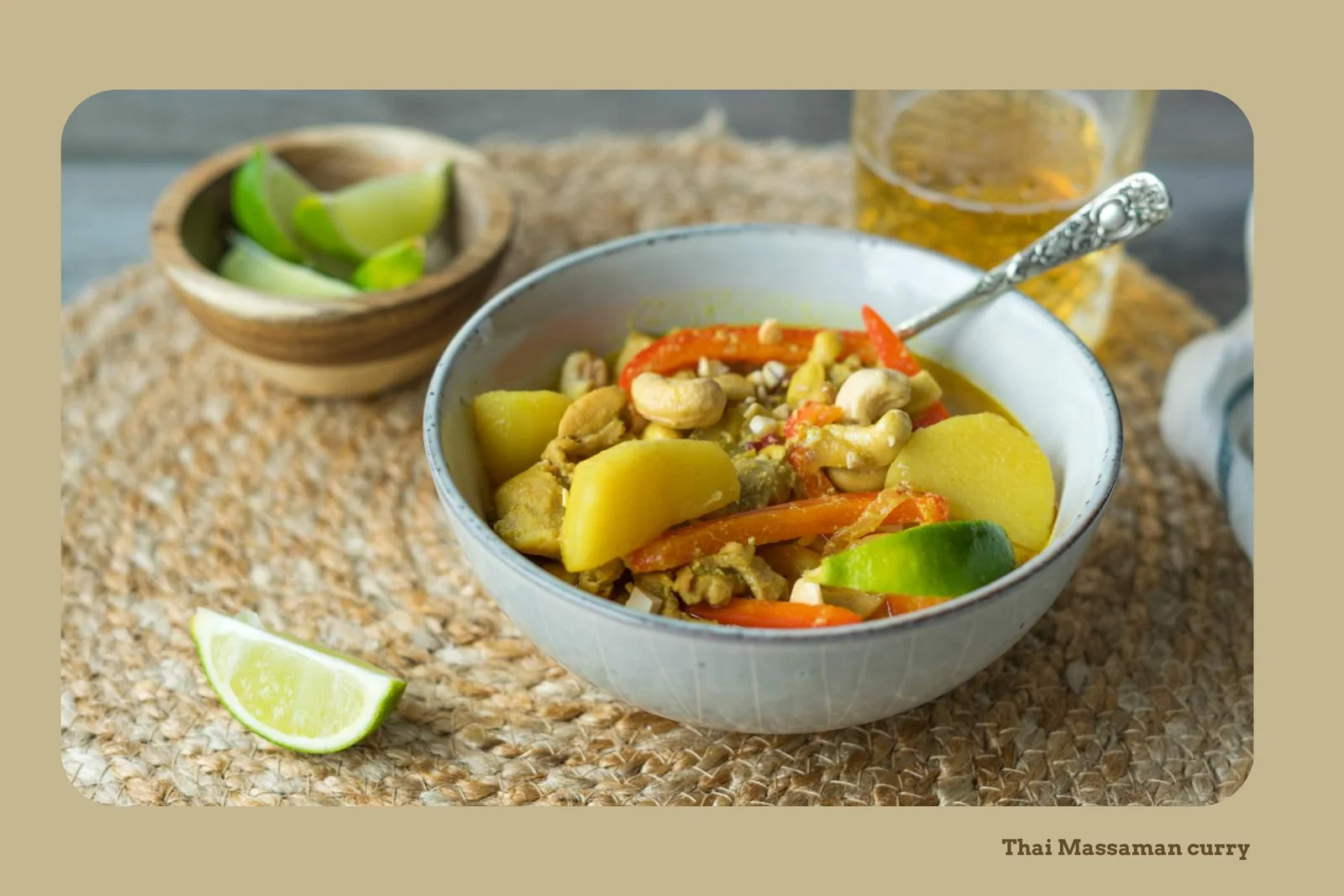
Image: Massaman curry
Panang Curry: The Creamy Delight
Thicker and less soupy than other curries, Panang is a creamy, mildly spicy curry with a slightly sweet edge.
- Usually made with beef
- Features a coconut base and a hint of ground peanuts for extra richness
- It’s a great entry-level curry for those new to Thai food or sensitive to spice
Thai curries are more than meals — they’re a crash course in Thailand’s regional diversity, cultural influences, and love for balance in flavor. If you’re on the hunt for the most flavorful local foods to try in Thailand, these curries are a must.
V. Thai Soups: Complex Broths and Aromatic Herbs
Thai soups are flavor-packed, deeply aromatic, and anything but simple. Whether you’re sipping from a street-side stall or a family kitchen, you’ll find that these bowls are layered with herbs, spices, and soul.
If you’re hunting for local foods to try in Thailand, don’t skip the soups — they’re some of the most iconic (and addictive) dishes the country has to offer. Here’s a look at the must-tries:
Tom Yum Goong: Thailand’s Famous Hot and Sour Soup
No food journey through Thailand is complete without this fiery favorite.
- Made with: shrimp, lemongrass, galangal, kaffir lime leaves, chilies
- Two versions to try:
- Tom Yum Nam Sai – clear, bright, and bold
- Tom Yum Nam Khon – richer, with a splash of coconut milk
It’s spicy, tangy, and bursting with Thai herbs — a full-on sensory experience in one bowl.
Tom Kha Gai: Coconut Chicken Soup
A gentler, creamier cousin of Tom Yum.
- Made with: chicken, coconut milk, galangal, lemongrass, kaffir lime leaves
- Flavor: tangy, sweet, savory — but smooth and comforting
Perfect for first-timers or anyone who loves balance over heat.
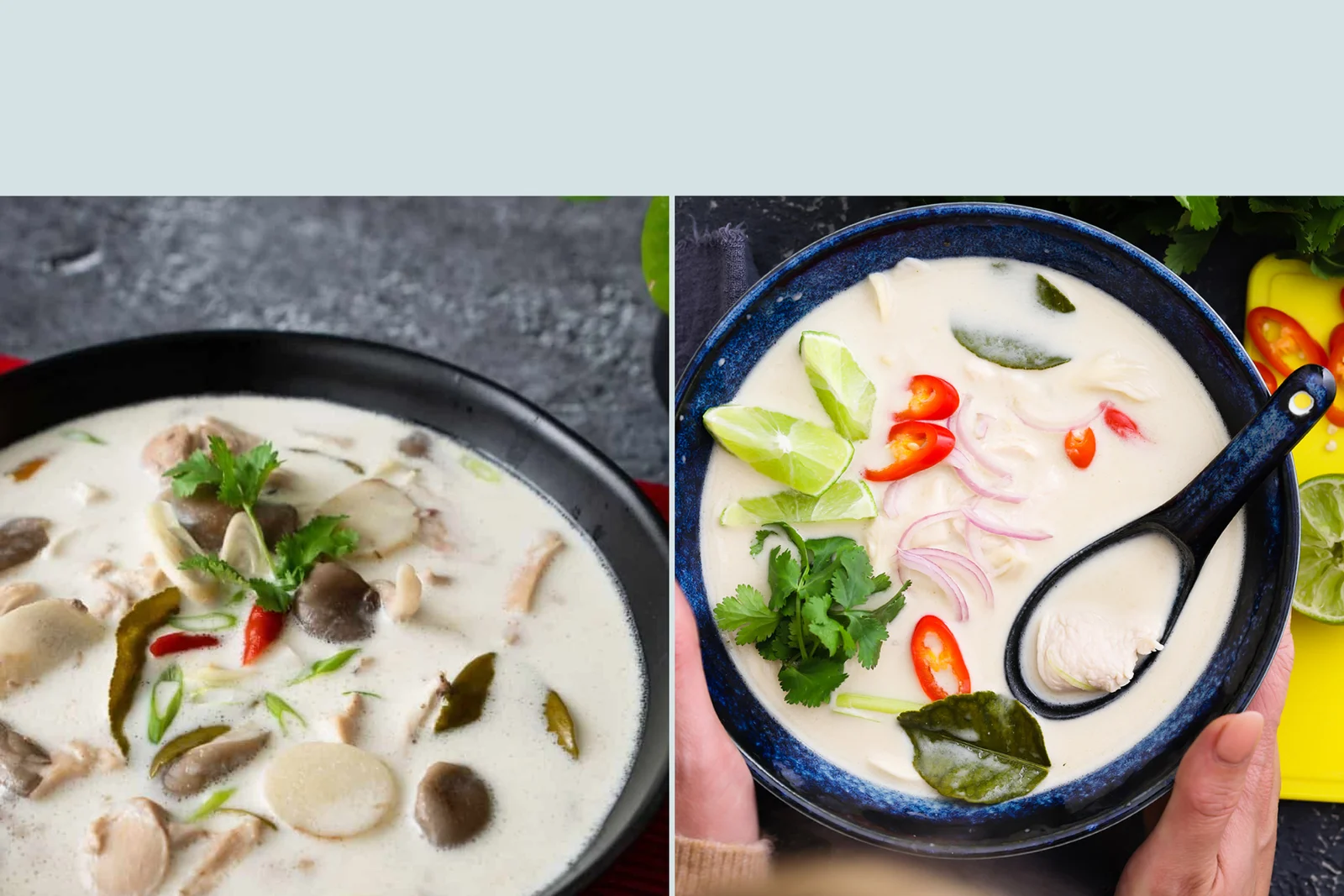
Image: Tom Kha Gai
Kuay Tiew: Thai Noodle Soups for Every Occasion
You’ll find noodle soup stalls on nearly every corner — and each one has its own specialty. Affordable, fast, and deeply local, these are everyday comfort bowls for Thai people.
Popular variations include:
- Kuay Tiew Moo – Pork noodle soup
- Kuay Tiew Gai – Chicken noodle soup
- Kuay Tiew Rua – “Boat noodles” with dark, spiced broth and meat
- Yen Ta Fo – Pink noodle soup with seafood and fermented tofu
Pro tip: No two bowls are ever the same — each vendor has their own recipe and secret ingredients. It’s one of the most fun ways to taste your way through Thailand.
Both Thai and Mexican food are fire—literally 🔥. Here are the best local foods to try in Mexico.
VI. Sweet Endings: Thai Desserts and Refreshments
You can’t talk about local foods to try in Thailand without mentioning dessert — and trust us, Thai sweets are in a league of their own. They’re all about unexpected textures, tropical ingredients, and that signature balance of flavors Thai cuisine is known for.
From rich coconut cream to crispy crepes filled with meringue and egg yolk threads, these desserts might surprise your palate — but in the best way.
Thai Desserts: The Perfect Balance of Sweet and Savory
Thai desserts often feature ingredients that might seem unusual to Western palates, such as beans, corn, and even egg yolks. However, these sweet treats showcase the same balance and harmony found in savory Thai dishes.
Mango Sticky Rice (Khao Niew Mamuang)
The unofficial queen of Thai desserts.
- Soft, sweet sticky rice
- Slices of ripe, juicy mango
- A drizzle of warm coconut cream
- Often served seasonally, this dish is simple, satisfying, and endlessly craveable.
Khanom Buang – Thai Street Crepes
These delicate mini-crepes are crispy on the outside and creamy (or savory!) on the inside.
Filled with:
- Sweet version: whipped meringue + egg yolk threads (foi thong)
- Savory version: shredded coconut + dried shrimp
You’ll find them sizzling fresh at most night markets — perfect for an on-the-go treat with a mix of crunch and creaminess.

Image: Colorful Thai crepes
🍬 Thai desserts may surprise you with ingredients like beans, corn, or egg — but that’s part of the fun. They reflect the same creativity and balance found in Thailand’s savory dishes, just with a sweet twist.
Refreshing Thai Beverages
After a spicy meal or a long day exploring markets, Thai drinks hit the spot like nothing else. Whether it’s a tall glass of sweet iced tea or a frosty fruit shake, these refreshing sips are just as much a part of the local foods to try in Thailand as the savory dishes and desserts.
Here are two you shouldn’t leave Thailand without tasting:
Thai Iced Tea (Cha Yen)
You’ll spot this drink by its bold orange color — and once you try it, you’ll know why it’s so popular.
- Made with strong brewed black tea, sweetened condensed milk, and evaporated milk
- Poured over ice and sometimes topped with foam
It’s sweet, creamy, slightly spiced, and perfect for cooling down after a fiery bowl of Tom Yum.
Fresh Fruit Smoothies and Juices
Thailand’s tropical climate = fruit paradise.
- You’ll find juice carts and smoothie stalls on nearly every corner
- Popular flavors include:
- Watermelon
- Pineapple
- Mango
- Passionfruit
- Dragon fruit
- Even mangosteen when in season!
Many vendors blend fruit with just ice and a touch of syrup or milk — ask for “mai waan” (not too sweet) if you prefer it light.
🍹 Whether you’re staying hydrated or balancing out the spice, these drinks are as much a part of the Thai food experience as any dish on your plate. They’re cool, colorful, and totally refreshing — just like Thailand itself.
VII. Navigating Thai Food Markets and Street Stalls
Thailand’s food markets are where the real magic happens — colorful stalls, sizzling woks, and endless choices. But if it’s your first time, the chaos can feel overwhelming (in the best way!).
Here’s how to confidently explore the local foods to try in Thailand, one street stall at a time:
Finding the Best Local Eateries
The number one rule? Follow the locals.
If a stall is packed with Thai customers, chances are the food is fresh, tasty, and authentic.
- Look for spots with high turnover — it means ingredients are constantly being refreshed
- Trust the lines: If people are waiting, it’s worth it
- With Gohub’s reliable eSIM, you can
- Check real-time reviews on Google Map
- Translate menus with your phone
- Even ask locals via chat apps for hidden gems nearby!

Image: Screenshot of the GoHub eSIM webpage, highlighting the destination input field with “Thailand” selected, illustrating how users can easily search for eSIM data plans.
Food Safety Considerations
Street food in Thailand is generally safe — but a few smart habits go a long way:
- Choose busy stalls with a crowd
- Watch for vendors who don’t handle cash and food with the same hands
- Go for items that are cooked fresh in front of you
- Stick to fruits that are peeled or peelable (like mango, banana, or rambutan)
Essential Thai Food Vocabulary for Travelers
Learning a few simple Thai words will make your market experience more fun (and often get you an extra smile or bigger portion 😄):
- Aroi (อร่อย) – Delicious
- Mai pet (ไม่เผ็ด) – Not spicy
- Pet noi (เผ็ดน้อย) – A little spicy
- Pet mak (เผ็ดมาก) – Very spicy
- Khob khun (ขอบคุณ) – Thank you
💡 Bonus: If you say “aroi mak!” (very delicious), don’t be surprised if the vendor beams with pride.
VIII. Dietary Restrictions and Thai Cuisine
Thailand is incredibly food-friendly — even for those with special dietary needs. While some ingredients (like fish sauce or soy sauce) are common in traditional cooking, many dishes can be adjusted to suit vegetarian, vegan, or gluten-free diets — especially in major cities and tourist hubs.
Vegetarian and Vegan Options
Fish sauce (nam pla) is used in many Thai recipes, but there are plenty of ways to eat plant-based while exploring local foods to try in Thailand.
- “Gin jay” (กินเจ): Refers to strict vegan food, free from animal products and strong-smelling herbs like garlic or onions (often seen during the Vegetarian Festival)
- “Mang sa wirat” (มังสวิรัติ): Refers to vegetarian food, which may include dairy or eggs
💡 In tourist areas like Chiang Mai or Bangkok’s Ari and Silom neighborhoods, you’ll find plant-based cafes, jay restaurants, and markets with clearly labeled options.
Gluten-Free Thai Food
Many Thai staples are naturally gluten-free — thanks to the heavy use of rice noodles, rice flour, and sticky rice over wheat.
- Use your Gohub eSIM to quickly translate ingredient lists or double-check with restaurant staff
- Dishes like Pad Thai, green curry, mango sticky rice, and most grilled meats are typically gluten-free
- Soy sauce (used in stir-fries) may contain wheat — always double-check if you’re celiac

Image: Mango sticky rice stall
IX. Regional Food Itineraries: Where to Eat What in Thailand
Want to taste your way across the country? Here’s your food-lover’s map to the most flavorful regional specialties — and where to find them:
Bangkok – The Ultimate Thai Food City
As Thailand’s capital, Bangkok is a melting pot of flavors from every region. From night markets to high-end food courts, you can eat around the country without ever leaving the city.
- Yaowarat (Chinatown): Evening street food heaven — seafood, grilled skewers, mango sticky rice
- Or Tor Kor Market: Premium produce market with a legendary food court
- Chatuchak Weekend Market: Beyond shopping — try dishes from across the country in one place
Chiang Mai – Northern Thai Culinary Exploration
In the north, things get a little spicier, a little smokier, and a lot more herb-forward.
- Warorot Market: Taste iconic dishes like Khao Soi (curried noodles) and Sai Oua (herbed sausage)
- Sunday Walking Street: A foodie dream — endless stalls in a festive old town setting
- Nimman Area: Stylish cafes serving modern spins on traditional Lanna cuisine
Phuket & Southern Thailand – Seafood and Spice
Southern Thai food is intensely spiced, deeply flavorful, and heavily influenced by Muslim and Peranakan culture.
- Phuket Town: Charming streets packed with curry rice stalls and Chinese-Malay fusion
- Hat Yai: Known for crispy fried chicken and Malaysian-style roti
- Nakhon Si Thammarat: Where you’ll find authentic Southern dishes at their spiciest
Traveling between regions: Thailand is long and varied — overnight trains, flights, and buses are all part of the adventure. With Gohub’s eSIM, you stay connected the entire way — perfect for looking up restaurant reviews, booking food tours, or translating menus when you’re deep in the spice zone of the south.

From Bangkok’s night markets to Parisian cafés, foodie adventures await. Don’t miss these must-try French foods.
X. Conclusion: Embracing Thailand’s Culinary Heritage
The local foods to try in Thailand are so much more than just tasty meals — they’re your ticket into the country’s heart. Every dish tells a story of region, history, and tradition, from the creamy curries of the south to the herb-loaded delights of the north. Whether it’s your first spoonful of Tom Yum Goong or a sticky handful of khao niew in a night market, Thai food invites you to slow down, savor, and connect.
As you explore, don’t be afraid to go off the beaten path. The most unforgettable bites often come from the smallest stalls, the quietest alleys, or the recommendation of a friendly local. Armed with a few key phrases, an open mind, and reliable connectivity through Gohub’s international eSIM, you’ll be ready to dive into Thailand’s vibrant food scene with confidence.
📶 Need directions to that tucked-away noodle cart? Want to post your mango sticky rice moment in real time? Stay connected with Gohub’s eSIM — no roaming fees, no SIM card swaps, just instant access across Thailand.
👉 Here’s how to install your eSIM on iPhone — it only takes a minute, and you’ll be all set to eat your way through Thailand, one unforgettable dish at a time.


